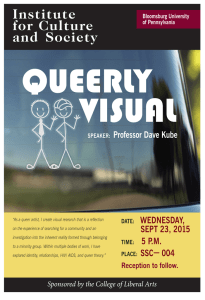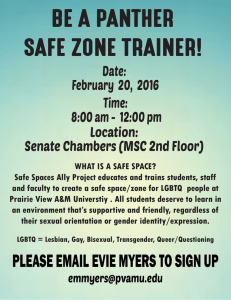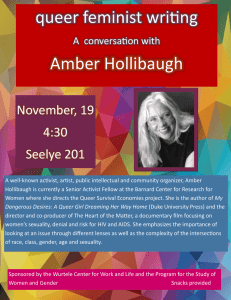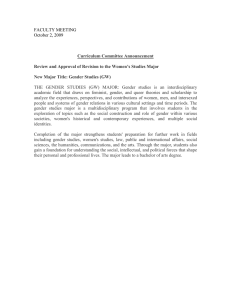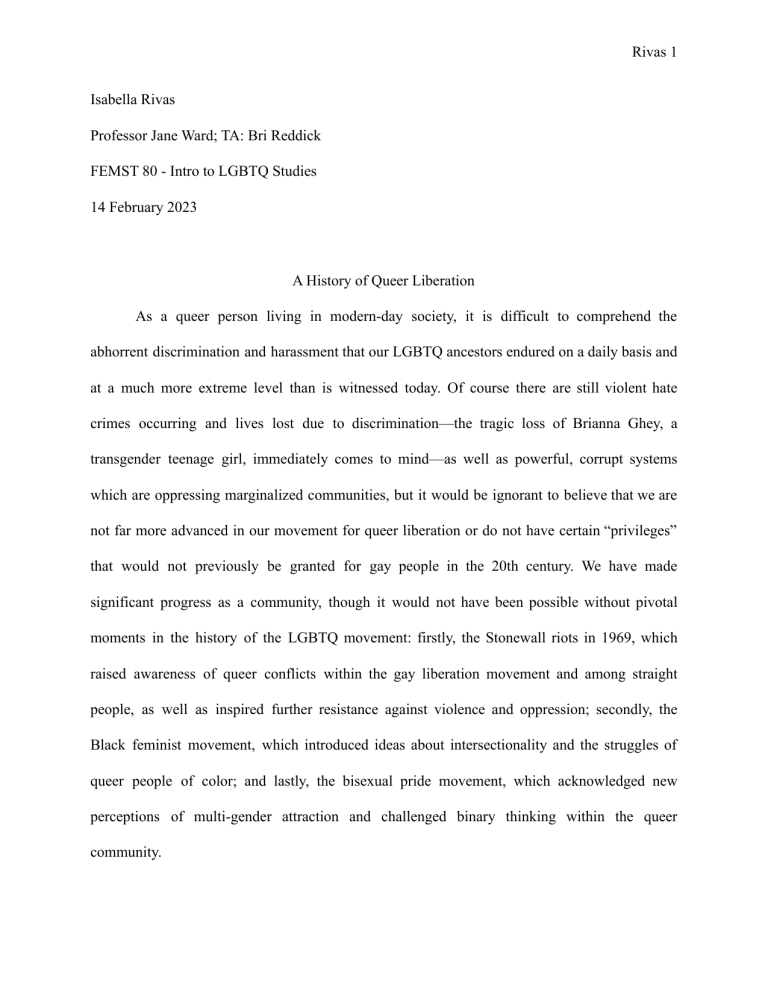
Rivas 1 Isabella Rivas Professor Jane Ward; TA: Bri Reddick FEMST 80 - Intro to LGBTQ Studies 14 February 2023 A History of Queer Liberation As a queer person living in modern-day society, it is difficult to comprehend the abhorrent discrimination and harassment that our LGBTQ ancestors endured on a daily basis and at a much more extreme level than is witnessed today. Of course there are still violent hate crimes occurring and lives lost due to discrimination—the tragic loss of Brianna Ghey, a transgender teenage girl, immediately comes to mind—as well as powerful, corrupt systems which are oppressing marginalized communities, but it would be ignorant to believe that we are not far more advanced in our movement for queer liberation or do not have certain “privileges” that would not previously be granted for gay people in the 20th century. We have made significant progress as a community, though it would not have been possible without pivotal moments in the history of the LGBTQ movement: firstly, the Stonewall riots in 1969, which raised awareness of queer conflicts within the gay liberation movement and among straight people, as well as inspired further resistance against violence and oppression; secondly, the Black feminist movement, which introduced ideas about intersectionality and the struggles of queer people of color; and lastly, the bisexual pride movement, which acknowledged new perceptions of multi-gender attraction and challenged binary thinking within the queer community. Rivas 2 In June of 1969, at a New York City gay bar called the “Stonewall Inn,” had riots erupting for a few days in response to the harassment and unfair arrests from the police inflicted upon trans people and drag queens who frequented this bar and valued it as their only safe space. The police would constantly cause disturbances, dragging harmless patrons onto the streets or into police stations for minuscule offenses, but the queers had eventually become angry at this treatment, leading to a strong reaction of protest and resistance as groups of queens, trans people, and fellow queers swarmed Stonewall and demanded to be heard, to be seen (Meem 75). This courageous act at Stonewall Inn is now reflected upon as an essential symbol of the fight for queer rights and visibility, shedding light on the struggles and the violence which gay and trans people endured every day of their lives. For example, after the riots had occurred, numerous political groups fighting for queer liberation became more direct and upfront about their political endeavors, and a significant amount of non-conformist, queer organizations began to form, or rather, some which were already formed like the Gay Liberation Front (GLF) thought it was important to use Stonewall as a platform to fight for their rights and raise awareness (Meem 76). Furthermore, a number of queer-focused publications emerged which invited conversation about the harsh reality that queer people have to survive in—the inability to keep a job, the homelessness, the assault and violence inflicted upon them, the inability to just be a human being—and it also raised consciousness about how the heteronormative culture prevalent in the late 1960s was contributing to the oppression of queer people (Jay and Young 293-296). By addressing all these issues and actively encouraging educational discussion on queer issues; by organizing an array of marches, protests, and organizations which prioritize queer liberation; and through directly challenging existing power structures, the LGBTQ movement increased Rivas 3 visibility, power, respect, and acceptance, allowing for more growth and safety within the queer community and which, ultimately because of Stonewall, led to notable victories in the fight for queer liberation that have transformed our society today. As a result of the LGBTQ movement becoming more visible and as conversations of queer politics are introduced, concerns within the community surrounding racism and sexism are addressed. In particular, the most significant issue being the exclusion of black women and other women of color in queer, feminist spaces. For example, the Combahee River Collective Statement, created by a group of black feminists in the late 1970s, describes the different intersecting struggles that Black women endure as they are committed to fighting for liberation, yet are met with oppressive forces within the feminist and queer movement from white gays and lesbians. They address the invisibility and lack of solidarity or safe spaces within their communities, stating, “…we are not just trying to fight oppression on one front or even two, but instead to address a whole range of oppressions. We do not have racial, sexual, heterosexual, or class privilege to rely upon, nor do we have even the minimal access to resources and power…” (Smith 96) which illustrates the notion of intersectionality, a concept describing the overlapping, complex ways in which parts of your identity (race, class, gender, etc.) interact with one another (Meem 167). Black feminists start to incorporate this idea within queer and feminist discussions, and, as a result of acknowledging this discrimination, they sought to create safe spaces for women of color in the queer community, and aimed to amplify the voices of marginalized people who have suffered layers of oppression and may not feel completely seen or heard by their own community. This is an incredibly powerful and important feat that is still relevant today, as queer Rivas 4 women of color and trans people of color continue to face discrimination and marginalization, but still fight to create inclusive and supportive spaces for each other. The Bi Pride movement signifies a different kind of conflict within the LGBTQ community, one that challenges ideas shared by gays and lesbians and, eventually, forces the queer liberation movement to evolve into an even more inclusive spectrum of people. One book, titled Bi Any Other Name: Bisexual People Speak Out, offers insight into the meaning of bisexual and how the very existence of it should provoke conversation about binary thinking in the heterosexual and homosexual world. For example, it states, “Coming out bisexual…challenges current assumptions about the immutability of people’s orientations and society’s supposed divisions into discrete groups…[and] challenges other people’s understanding of themselves” (Hutchins and Kaahumanu 3). The acknowledgement of attraction to multiple genders deconstructs the idea that people must fit into one category or another; that you are either gay or straight, male or female. Additionally, going along with the Black feminist movement and that awareness of intersectionality, the Bi Pride movement creates its own larger discussion of intersectionality and the importance of recognizing that there are various unique identities that intersect with sexual orientation. Bisexuality, as stated in the text, is not a static identity, but one that naturally evolves and shifts in a more complex manner. It is a different way of approaching a heteronormative world by celebrating all genders and orientations and not succumbing to the notion that one must be completely firm in their sexual identity (Hutchins and Kaahumanu 8). This particular movement is especially prevalent today as it appears that a large population of people in the queer community still have bouts of binary thinking, which can be seen on social media where people are sometimes shamed or criticized for using any label Rivas 5 besides “gay” or “lesbian” because biphobia is sadly alive and well in the LGBTQ community, or even in the celebrity world, if you are a queer man who is seen with a woman, you are immediately regarded as straight, no matter what that person claims his own sexuality to be otherwise because there is no other option that is valid. As is the case with other liberation movements striving for positive change, there are bound to be issues within the LGBTQ movement itself that are necessary for the evolution of this community, such as the lack of understanding for intersectional oppression or contradictory thinking which could exclude minorities and people who are different to most in the community, but there are also exceptional people and events that are positively impactful to the queer liberation movement as well. The positive impact is displayed through the bravery of the trans women who rioted at Stonewall Inn, which was the catalyst for several movements after, while some of the more challenging conflicts within the community could be seen through the Black feminist movement and the Bi Pride movement. Yet, it is important to recognize that the LGBTQ community is still an incredibly strong and supportive group, having lived through generations of trauma and violence but still managing to fight for the freedom of all people. Looking back then and observing where we are now, I believe that there is much hope that no matter what obstacles the queer community faces, we can overcome it together because it is our mutual love and respect for each other that truly unites us. Rivas 6 Works Cited Hutchins, Loraine, and Lani Kaahumanu. “Overview.” Bi Any Other Name: Bisexual People Speak Out, Riverdale Avenue Books, Riverdale, New York, 1991, pp. 3–8. Jay, Karla, and Allen Young. “Notes on Gay Male Consciousness-Raising.” Out of the Closets: Voices of Gay Liberation, New York Univ. Press, New York, New York, 1992, pp. 293–296. Meem, Deborah T., et al. “Imagining Liberation.” Finding out: An Introduction to LGBTQ Studies, SAGE Publications, Inc., Thousand Oaks, California, 2014, pp. 75–76. Meem, Deborah T., et al. “Intersectionalities.” Finding out: An Introduction to LGBT Studies, SAGE Publications, Inc., Thousand Oaks, California, 2014, p. 172. Smith, Barbara. “The Combahee River Collective Statement.” Home Girls: A Black Feminist Anthology, Kitchen Table, Women of Color Press, New York, New York, 1983, pp. 95–99. Rivas 7
